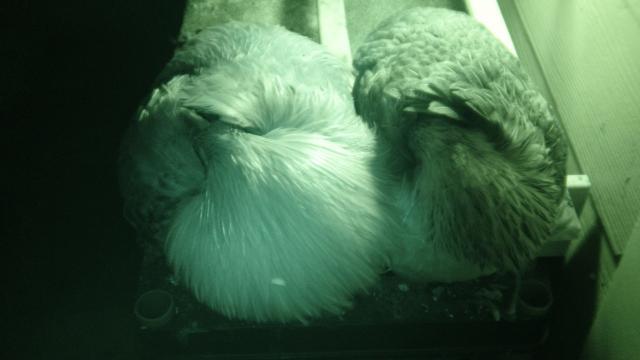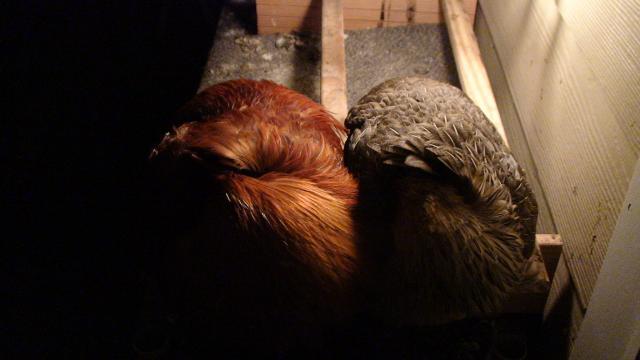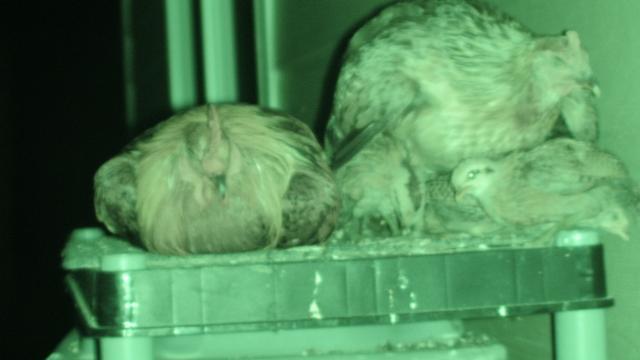Some roost designs may prove better when birds tend to crowd pushing somebody off. The round, more natural shape limits the angles birds can push each other from although even 1 x 2 lats can provide that benefit and are much cheaper than dowels produced by expensive milling. Frostbite risk in my experience at higher latitudes and little or no protection from winter conditions has little to do with roosting arrangements other than the birds need to be up on dry surfaces that are good insulators of heat which wood is a good example.
Navigation
Install the app
How to install the app on iOS
Follow along with the video below to see how to install our site as a web app on your home screen.
Note: This feature may not be available in some browsers.
More options
You are using an out of date browser. It may not display this or other websites correctly.
You should upgrade or use an alternative browser.
You should upgrade or use an alternative browser.
HOW WIDE SHOULD THE ROOST BE?
- Thread starter Fawn and Fam
- Start date
- Thread starter
- #12
- Apr 2, 2013
- 270
- 16
- 166
Thanks everyone


- May 25, 2012
- 36
- 5
- 24
My Delawares roost on anything, but they prefer 2" boards that I have rounded off the edges with a router. 2x2's and 2x4's both support their slumber requirements. It seems they prefer rounded roosts rather than flat roosts.
I don't think anyone has said they "have to" more just it's a suggested idea for those who do get cold, my girls definitely sink down and cover their feet, and while i have not personally had frostbite in a chickens feet, i have seen it and i think using ideas that may lessen it does not go a miss.Interesting how you can get so many differing opinions on something like this. I wonder how many people have actually seen a case of frostbite on chicken’s feet or actually know of a specific case instead of just “THEY say you have to do this”?
For some areas you don't get cold enough, if you barely drop below zero, that is not cold, we get cold here and their are areas even worse than myself.
Thank you. You are the first person I’ve seen on this forum that has ever said they have actually seen frostbite on a chicken’s feet. It’s bound to happen. There are just too many chickens out there for something like that to not happen.
I’m not trying to be a smart-aleck or start an argument, but do you happen to know if that was size of roost-related or if maybe there was a different cause, like maybe them walking in the water to get the feet wet or maybe they were roosting on metal or plastic instead of wood?
I agree it doesn’t get that cold here for chickens. I’ve seen them sleep in sheltered spots in trees around zero Fahrenheit. No frostbite or any other problems. That’s why I mentioned there is nothing wrong with using flat-side up. That way you are covered no matter what.
I’m not trying to be a smart-aleck or start an argument, but do you happen to know if that was size of roost-related or if maybe there was a different cause, like maybe them walking in the water to get the feet wet or maybe they were roosting on metal or plastic instead of wood?
I agree it doesn’t get that cold here for chickens. I’ve seen them sleep in sheltered spots in trees around zero Fahrenheit. No frostbite or any other problems. That’s why I mentioned there is nothing wrong with using flat-side up. That way you are covered no matter what.
I have seen it. Never has it been roost related under conditions I maintain where adults sleep under stars. Frostbite was secondary to other health issues such as infection resulting from wounds or excessive parasite burden. Afflicted bird first had issues suppressing infection then when weakened with low temperatures, blood was shunted from extremities (feet and comb/wattles) to core in battle against hypothermia. The actual freezing of tissues appears to take place during day when the extremities are exposed rather than at night when head is tucked under wing and down plus hot breast is settled over feet to warm them. The birds do not sleep with feet or head exposed (see images and link below).Thank you. You are the first person I’ve seen on this forum that has ever said they have actually seen frostbite on a chicken’s feet. It’s bound to happen. There are just too many chickens out there for something like that to not happen.
I’m not trying to be a smart-aleck or start an argument, but do you happen to know if that was size of roost-related or if maybe there was a different cause, like maybe them walking in the water to get the feet wet or maybe they were roosting on metal or plastic instead of wood?
I agree it doesn’t get that cold here for chickens. I’ve seen them sleep in sheltered spots in trees around zero Fahrenheit. No frostbite or any other problems. That’s why I mentioned there is nothing wrong with using flat-side up. That way you are covered no matter what.
Additionally, high moisture environments associated with poorly ventilated coops can saturate feathers degrading insulation value making bird to take steps to conserve core temperature. I have seen this with birds overly confined to protect them from elements.
Nutrition can compensate within limits.
See link to following thread showing normal sleeping position. You gotta be sneaky to see. This directly related to frostbite / roost interactions.
https://www.backyardchickens.com/t/454020/interesting-picture-of-chickens-sleeping


Sleeping positions when warm. When hot they often sleep with necks extended. Chicks are forcing their way under mother and sometimes father which is only time I see sleeping birds stand.

I can post images of frost bite on feet after wounds healed over. In that situation frost bite was secondary to infection related to fighting through wire.
Last edited:
- Sep 24, 2012
- 142
- 10
- 71
My birds sleep on a 1-1.5" diameter branch but it doesn't get that cold here. However their breast feathers actually can wrap around the branch so it covers their feet completely. I almost looks like the chickens were skewered by the roost bar.
That is very much true although my images above do not show it owing to limitations of aspect.My birds sleep on a 1-1.5" diameter branch but it doesn't get that cold here. However their breast feathers actually can wrap around the branch so it covers their feet completely. I almost looks like the chickens were skewered by the roost bar.
I have bantams and large birds, and use saplings, bark on, 3" to 4" in diameter. Mary
New posts New threads Active threads
-
Latest threads
-
-
-
-
Love bird laying insane amount of eggs?
- Started by Silkiebegins
- Replies: 2
-
Love bird laying insane amount of eggs?
- Started by Silkiebegins
- Replies: 0
-
-
Threads with more replies in the last 15 days
-
-
-
Ended Official BYC Caption Contest 05-10-24 Pic by LavenderDaFlerf
- Started by BYC Project Manager
- Replies: 81
-
-
Does everyone stress ordering chicks the first time 😱
- Started by Esrun
- Replies: 70
-



